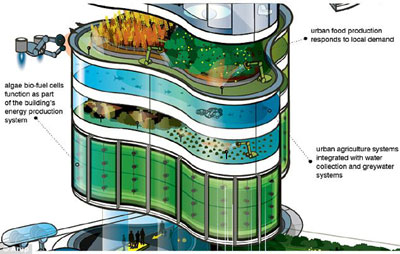What will a skyscraper built in 2050 look like? How will it function?
Rather than being static as they are today, in the future buildings will produce food, energy and resources.
They will be "living buildings" whose intelligent systems adjust to the needs of inhabitats, respond automatically to variations in weather, are reconfigured by robots and produce more resources than they consume.
Engineering firm Arup, which designed the iconic Sydney Opera House and is building a zero-carbon city in Dongtan, China, produced a report, ‘It’s Alive,’ to help the company and clients envision future buildings.
"The urban building of the future essentially functions as a living organism in its own right – reacting to the local environment and engaging with the users within," writes Josef Hargrave, a consultant with firm’s Foresight + Innovation division.
Of course, the building of the future is powered by renewable energy – in this case from external walls coated with photovoltaic paint, micro-wind turbines and an algae facade to produce biofuels. A nano-particle membrane captures waste carbon and converts it to oxygen.
Vertical farms, which we’re already seeing built, will be standard ways to produce meat, poultry, fish, and vegetables.
Brain-like ‘intelligent building systems’ will make "calculated" decisions about how to optimize resources by constantly tracking data on energy consumption, weather, and the needs of residents.
Much of the building will be modular. Depending on what’s needed, robots could swap in or out components that provide food, such as animal, fish or vegetable farms. Robots would also be able to "work seamlessly together to install, detect, repair and upgrade components of the building system, says the report.

"By 2050, the human population will have reached 9 billion people with 75 per cent of the world’s inhabitants living in cities. This report explores the idea of intelligent buildings that are able to make informed and calculated decisions based on their surrounding environment – living and breathing structures that are able to support the cities and people of tomorrow," Hargrave.
Arup’s mock-up for the building of the future embodies five attributes: flexibility, sustainability, reactivity, community integration and smart systems.
The building has a "dynamic network of feedback loops characterized by smart materials, sensors, data exchange, and automated systems that merge together, virtually functioning as a synthetic and highly sensitive nervous system," it says.
Many of the concepts are already becoming familiar, such as integrated micro systems that generate on-site energy; water collection and recycling systems; heat recovery surfaces; building membranes that can convert carbon dioxide into oxygen; and even urban food production modules where residents can get meat, poultry, fish and vegetables.
Other ideas are far more futuristic. Buildings will be far more modular, created out of components that can be easily upgraded or rearranged over time – and even assembled by robots. The materials will also be capable of self-repair and maintenance.
This will be accomplished through a multi-layered approach: a permanent layer at the bottom, a 10- to 20-year layer (which includes the facade and primary fit-out walls, finishes, or on-floor mechanical plant), and a third layer that can incorporate rapid changes, such as new IT equipment.
"In the ecological age, buildings do not simply create spaces, they craft environments," writes Hargrave. "They function as part of an urban ecosystem, promote more environmentally conscious and efficient resource management, and actively contribute to the unique needs of the individual user, as well as the wider requirements of the city."
Here’s Arup’s report:
